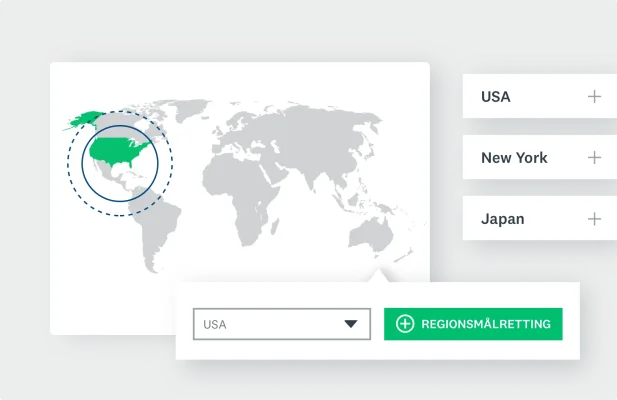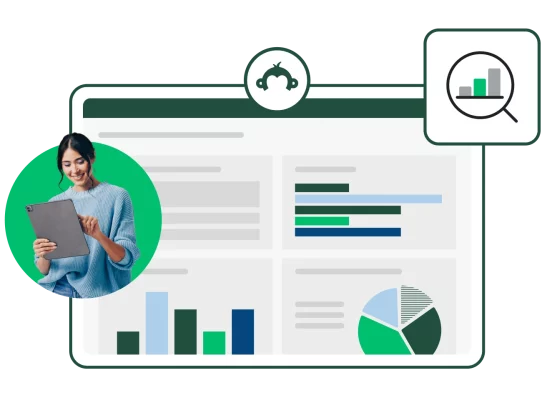Fem typer markedssegmentering og hvordan de brukes (med eksempler)

- Markedssegmentering betyr å kategorisere et bredt forbrukermarked i mindre, distinkte grupper basert på delte egenskaper.
- Segmentering av markedsandeler er avgjørende, siden den gjør det mulig for bedrifter å ta sikte på spesifikke grupper mer effektivt. Dette fører til bedre kundetilfredshet og bedre forretningsresultater.
- De fem typene markedssegmentering er demografisk, psykografisk, atferdsbasert, geografisk og bedriftsdemografisk segmentering.
Se på kundene som en levende mosaikk, alle unike, men samtidig har de likheter. Markedssegmentering er kunsten å gjenkjenne disse mønstrene, gruppere kunder basert på felles egenskaper og lage strategier som appellerer til deres kollektive behov og ønsker.
Etter å ha etablert grupper med markedssegmentering, kan bedriftene annonsere mot disse segmentene mer effektivt. Hvert segment kan ha bestemte preferanser som skiller dem. Etter hvert som bedrifter fokuserer på det hver gruppe ønsker å se, kan de øke engasjementet, øke interaksjonen og øke salget.
Hva er markedssegmentering?
Markedssegmentering er prosessen med å dele opp en større befolkning i undergrupper i henhold til visse delte faktorer. Disse gruppene kan ha felles demografi (alder og kjønn osv.), geografisk plassering, holdninger, atferd eller en kombinasjon av lignende karakteristiske egenskaper.
Ved å opprette mindre grupper basert på felles faktorer, er det lettere å nå målgruppene.
Kjenner du til målmarkedets karakteristikker?
Finn det ut på noen få minutter med SurveyMonkeys kundesegmentering.
Hvorfor bruke markedssegmentering?
Med markedssegmentering kan bedrifter utvikle detaljerte profiler for hvert markedssegment. Når disse markedssegmentene er tydelig definert, kan markedsførere velge de segmentene som mest sannsynlig vil kjøpe produktene og tjenestene til bedriften.
For å oppnå det målet må markedsførere gå gjennom en prosess på tre trinn som tydeliggjør hvem de menneskene er, og hvorfor de kjøper produkter.
- Segmentering: Markedsførere deler inn markedet i kategorier basert på delte egenskaper.
- Målgruppe: De velger det markedet eller den målgruppen som mest sannsynlig vil kjøpe produktene deres.
- Posisjonering: Markedsførere undersøker hvilke kombinasjoner av produkter, pris, kampanje og steder som vil lokke kunder til å kjøpe produktene.
Når markedsførere har isolert målgruppen, må de definere hva som gjør at produktet deres skiller seg ut. Er det bedre, raskere, billigere eller mer avansert enn konkurrentenes produkter? For å svare på disse spørsmålene, må markedsførere forstå hva målgruppens problemer er og hvordan de kan løse disse problemene.
Bedrifter kan skaffe seg et konkurransefortrinn gjennom produktdifferensiering, noe som får produktene og tjenestene til å stå fram som den beste løsningen på kjøpernes problemer.
Ved å identifisere et målmarked, isolere problemene til dette markedet og skape et produkt som løser disse problemene, er det mer sannsynlig at markedsførere lykkes sammenlignet med konkurrentene.
Eksempler på markedssegmentering
Markedssegmentering er det første trinnet i en vellykket markedsføring av et produkt. Uansett om markedsføring er rettet mot kunder eller virksomheter, kan markedssegmentering gi bedre innsikt i kundenes problemer og hvordan de kan løses.
Ikke alle bedrifter segmenterer ikke kundene sine på samme måte. Det er flere forskjellige tilnærminger bedriftene kan bruke.
Dette er tre vanlige eksempler på tilnærming til markedssegmentering.
Ingen segmentering
Bedrifter bruker massemarkedsføring for å selge produktene til alle, uten noen spesiell strategi. Bedrifter som selger råvarer som salt eller generiske varer der det finnes mange erstatninger, legger kanskje ikke så mye innsats i å segmentere markedet.
Begrenset segmentering
Bedrifter bruker ett eller flere smalt definerte målmarkeder for å skape et nisjemarked med fokus på spesialprodukter. Eksempler på dette er eksklusive moteplagg, håndlaget kunst eller spesiallagde maskindeler.
Tusenvis av segmenter
Dette er også kjent som hypersegmentering. Markedsførere kan lage markedsføringstilnærming med én-til-én-metoden for hver kunde for å danne grunnlag for forhold som varer over lengre tid. Personlige tjenester som frisørsalonger og nettbaserte detaljhandlere som Amazon tilbyr personlige anbefalinger basert på kjøpshistorikk.
Fem typer markedssegmentering
Enten bedriften vil ha en håndfull segmenter eller tusenvis, bør virksomheten ha kunnskap om de fem ulike typene markedssegmentering.
La oss se på demografisk, psykografisk, atferdsbasert, geografisk og bedriftsdemografisk segmentering, hva hver type innebærer og hvordan de kan brukes.
1. Demografisk segmentering
Demografisk segmentering antar at folk med lignende karakteristiske egenskaper vil ha lignende livsstilsmønstre, smak og interesser som vil påvirke kjøpsvanene deres. Demografi kombineres ofte med andre segmenteringstilnærminger for å utvikle målmarkeder som mest sannsynlig vil kjøpe produktene det dreier seg om.
Demografi omfatter faktorer som alder, kjønn, yrke, inntekt og utdanning.
Slik bruker man demografisk segmentering
Fordelen med demografisk segmentering er at den er enkel å implementere. Offentlige kilder, deriblant amerikanske Bureau of Labor Statistics, oppgir husholdnings-, inntekts-, utdannings- og helsedata for markedsføringsstrategier og forretningsmål.
Når markedsførere har brukt demografi til markedssegmentering, kan de bruke den samme informasjonen til kundesegmentering. Ved å bruke demografi og atferd kan de identifisere:
- Hvor stort er det potensielle markedet for produktet
- Hvordan ligger merkevaren an sammenlignet med konkurrentene
- Hvilken demografisk gruppe kommer mest sannsynlig til å kjøpe produktet eller tjenesten
- Hva slags kampanjer vil appellere mest til målmarkedet
Når man kombinerer dette med atferdsmønstre og andre variabler, gir demografisk segmentering verdifull innsikt og forståelse for hvilke bestemte kunder innenfor målmarkedet som vil kjøpe produktet. Man vil også få en bedre forståelse av hvordan de kan nås med riktig markedsføringsbudskap.
2. Psykografisk segmentering
Psykografisk segmentering deler mennesker inn i grupper basert på personlighet, livsstil, sosial status, aktiviteter, interesser, meninger og holdninger. Psykografi er et fint tillegg til demografi, siden det viser motivasjonen bak de ulike valgene folk tar.
Har du sjekket demografien til målmarkedet i det siste?
Endringer skjer raskt. Få nytt fokus med SurveyMonkeys kundesegmentering.
Slik bruker man psykografisk segmentering
Psykografisk segmentering er en effektiv måte å forstå kundenes problemer, atferd og holdninger på.
Bedrifter bruker psykografi i markedssegmentering for å forstå
- hvordan forbrukerne oppfatter produktene og tjenestene
- hva forbrukerne egentlig vil ha og hvorfor
- hvilke mangler eller smertepunkter nåværende produkter eller tjenester har
- hvilke potensielle muligheter som finnes for framtidig engasjement
- hvordan man kommuniserer bedre med målgruppen
3. Atferdsbasert segmentering
Atferdsbasert markedssegmentering beskriver bestemte trinn i idealkundens kjøpsprosess. Denne typen segmentering omfatter det idealkundene vil ha, hvorfor de vil ha det, fordelene de søker og hvordan de går frem for å dekke behovene sine.
Slik bruker man atferdsbasert segmentering
Atferdsbasert segmentering kan brukes av bedrifter til å studere B2C- og B2B-markedssegmenter. Når bedriftene forstår hvorfor folk kjøper noe, kan de bedre tilpasse markedsføringsbudskapet til målgruppen. Atferd kan omfatte:
- Kjøpsårsak: Ser kjøperne etter den beste prisen, gode kundevurderinger, sikkerhetsoverveielser eller andre kriterier?
- Anledninger eller arrangement: Handler forbrukere inn til en høytid, jubileum eller fest? Prøver B2B-oppkjøperne å bruke opp budsjettet før året er omme?
- Produktfordeler: Er kjøperne på utkikk etter det siste innen teknologi, det tryggeste produktet eller vil de være de første som kjøper et nytt produkt?
- Fase i kundereisen: Vil kjøperne ha informasjon for framtidige kjøp? Eller er de ute etter å prøve ut merkevaren for første gang?
- Engasjementnivå: Er kjøperen en blodfan som er på utkikk etter det nyeste produktet?
Når markedsførere vet hvorfor kundene eller virksomhetene kjøper produktene deres, kan de benytte denne atferden i segmenteringsstrategien sin.
4. Geografisk segmentering
Med geografisk segmentering kan markedsførere gruppere personer basert på hvor de bor, jobber eller reiser.
Geografisk plassering betyr mye for kjøpsvanene som markedsførere kan bruke til å utvikle markedsføringsbudskapet. Markedsførere bruker ulike geografiske segmenteringsvariabler som f.eks. land, område, fylke, provins, by, klimasone eller postnummer.
Kultur og befolkningstetthet (by eller land) er også viktige variabler å inkludere i markedsundersøkelsene. Disse geografiske variablene påvirker hvilke problem folk i det området har, og hvordan markedsførere kan løse dem.

Slik bruker man geografisk segmentering
Hvor noen bor kan påvirke alt fra matvalg til bilen de kjører. Bedrifter kan bruke geografisk segmentering til å finne de beste produktene de kan selge til kundene sine.
Et eksempel på geografisk segmentering er markedsføring av planter med utgangspunkt i klimasone. Pelargoniaer vil passe best på varme og solrike steder, mens blågran passer best på steder med kalde vintere. Med kjennskap til det geografiske områdets detaljer kan markedsførere identifisere hvilke planter, jord og hagetilbehør som vil selge best i hvert klima.
Et klesfirma kunne eventuelt anbefale tykke jakker til noen som bor på kaldere steder. Ved å tilpasse produktene som markedsføres til kunder basert på hvor de befinner seg, kan det drastisk endre hvor mye de vurderer et kjøp.
5. Bedriftsdemografisk segmentering
For B2B-markedsførere tilsvarer bedriftsdemografisk segmentering det demografi betyr for B2C-markedsførere. Bedriftsdemografi forklarer de karakteristiske egenskapene til bedriftens målmarked og omfatter bransjen, antall ansatte, virksomhetens juridiske status, bedriftens størrelse, økonomiske situasjon og andre virksomhetsrelaterte variabler.
Millioner av mennesker flytter hvert år. Har målmarkedets geografiske profiler endret seg? Finn det ut på bare noen minutter med SurveyMonkeys kundesegmentering.
Slik bruker man bedriftsdemografisk segmentering
Med bedriftsdemografi får markedsførere informasjon om bedrifters styrker og levedyktighet innenfor målmarkedene sine. Bedriftsdemografi fokuserer på økonomiske resultater og trender innenfor vekst for å se om markedssegmentet vokser eller er i nedgang.
Eksempler på bedriftsdemografiske data:
- Bransjeklassifisering: Standard for næringsgruppering, f.eks. North American Industry Classification System (NAICS).
- Eierskap og virksomhetens juridiske status: Eierskapsstatus, deriblant enkeltpersonforetak, aksjeselskap, privat bedrift og offentlige selskap eid av aksjonærer.
- Antall år i bransjen: Antallet år i bransjen kan være en indikator på økonomisk soliditet og bransjeerfaring.
- Antall ansatte: Antallet ansatte viser hvor stor bedriften er.
- Geografisk plassering: Geografisk plassering kan omfatte kontorer, fabrikker eller butikker.
- Kunder og produkter: Produktene bedriften lager eller selger, samt hvem som er målgruppen for disse produktene.
- Markedsstørrelse: Hvor stort markedet er, og hvem som er konkurrentene.
Fordeler med markedssegmentering

Markedssegmentering er grunnlaget for vellykkede produktkonsepter, -lanseringer, markedsføringsbudskap, reklame og andre viktige markedsføringsaktiviteter.
Bedrifter investerer store ressurser for å forstå idealkundens problemer, og for å kunne løse disse utfordringene med verdifulle produkter og tjenester. Hvilke fordeler får bedriftene av å investere tid og innsats i markedssegmentering?
Bedre reklamekampanjer
Selskaper bruker milliarder av kroner på markedsføring og reklame når de vet akkurat hvem målgruppen er, og hva de ønsker seg. Markedsførere innhenter store mengder data om målgruppen for å sikre at markedsføringsbudskapet appellerer til den rette kunden, på rett tidspunkt og for de rette produktene.
Spørreundersøkelser er en utmerket måte å teste markedsføringsbudskap på, for å se om de finner gjenklag hos målgruppen. De begynner med å lage en hypotese om hvordan de tror respondentene vil reagere. Med resultater fra spørreundersøkelser blir budskapene bedre og kampanjene mer vellykkede.
Utvikle de rette produktene
Bedrifter har ofte gode ideer til nye produkter, men de må fastslå om disse ideene løser et problem for målgruppen. Uten markedssegmentering vil bedriftene kaste bort tid og innsats på et produkt som høres bra ut, men som ikke selger.
Spørreundersøkelser tar pulsen på målmarkedet. På et par timer kan bedrifter finne ut om
- de løser et problem for målmarkedet.
- én eller flere av ideene er en klar vinner.
- dette produktkonseptet har de rette funksjonene, emballasjen og logoen.
- kjøperne vil kjøpe produktet, og hvilken pris de er villige til å betale.
Når man får de rette svarene fra et målmarked som er definert på en god måte, bidrar det til at bedriften kan fokusere på vellykkede produkter som målgruppen ønsker å kjøpe.
Med SurveyMonkeys produktkonseptanalyse får du vite om den nye produktideen er en vinner. Få et scorekort for produktets resultater med referansepunkter fra bransjen.
Identifisere nye trender og muligheter
Trendene er i rask endring. Sosiale medier kan gi innsikt i ny kundeatferd, men markedsførere vet ikke om det er levedyktige muligheter, med mindre disse atferdene måles.
Å forstå atferden til målmarkedet er kjernen i markedssegmentering. Når nye trender får fotfeste, er det opp til markedsførerne å finne ut hvilke som har potensial, og hvilke som vil forsvinne raskt.
Markedsførere har ansvaret for å identifisere nye kundeproblemer, definere nye markedsføringsbudskap og teste nye produktkonsepter. For å identifisere nye muligheter, må markedsførere hyppig teste målgruppen for å få ny innsikt, og bekrefte om kundene fremdeles ønsker de eksisterende produktene.
Bidra med innspill til forretningsvirksomhet
Markedssegmentering vil ha et robust datasett som omfatter kundedata som andre avdelinger kan bruke for å hjelpe bedriften med å lykkes. I B2B-selskaper er ofte markeds- og salgsavdelingene tett knyttet til hverandre, med salg avhengig av at markedsføringen skal generere kvalifiserte potensielle kunder som skaper mer inntekt.
Avdelingen som er ansvarlig for å prise produkter trenger også data om markedet og konkurrentene for å prissette produktene riktig og gi dem et konkurransefortrinn. Ingen fabrikkarbeidere ønsker å jobbe overtid fordi det plutselig må produseres 100 000 enheter for å dekke økt etterspørsel. Derfor vil opplysning om kjøpstrender og etterspørsel også holde produksjonen på rett spor.
Markedssegmenteringsdata er ikke bare nyttig for markedsføringsavdelingen. De bør deles så hele bedriften kan jobbe for kundene.
Etablere tillit til merkevaren
Bedrifter vil drive med andre ting enn bare salg av produkter til målgruppen. De vil etablere et forhold til kundene, slik at kundene fortsetter å kjøpe produktene deres. Når kundene kjenner, liker og fortsetter å kjøpe produktene til en bedrift, har de skapt merkevaretillit.
Markedssegmentering viser hvilken målgruppe som mest sannsynlig kommer til å kjøpe, ikke bare én gang, men også i fremtiden. Når bedrifter skaper en merkevareidentitet som kundene liker, øker de merkevarebevisstheten og bygger et tillitsbasert forhold til målmarkedet. Bedriften holder fokus på denne tilliten når de skaper markedsføringsbudskap, nye produkter, verdifullt innhold og oppdatert informasjon. Det igjen skaper en kundeopplevelse som gjør at kunder og B2B-kunder kommer tilbake for å handle mer fra bedriften i fremtiden.
Med målmarkedssegmentering kan markedsførere forstå idealkundens problem og atferd, lage løsninger og bygge langsiktig merkevaretillit som gagner begge parter.
Hva slags forhold har du til målgruppen din?
Finn ut hva som skal til for å bygge merkevaretillit med SurveyMonkeys merkevaresporer.
Segmentere dataene med SurveyMonkey
Hvis bedriften forstår markedssegmentering, kan de lage mer engasjerende, skreddersydd innhold som alle kundene vil like. Segmentering av målgruppen er avgjørende for å levere effektivt markedsføringsmateriell og øke engasjementet hos kundene.
Finn ut mer om hvordan du segmenterer dataene dine med SurveyMonkey, slik at du får detaljerte kundegrupper som muliggjør svært effektiv forretningskommunikasjon. Registrer deg i dag for å komme i gang med kundesegmentering.
Kom i gang med markedsundersøkelser
Globalt spørreundersøkelsespanel
Hent inn markedsundersøkelsesdata ved å sende spørreundersøkelsen ut til et representativt utvalg.
Ekspertløsninger
Test creative or product concepts using an automated approach to analysis and reporting.
